
Concept explainers
Review. A block of mass m1 = 2.00 kg and a block of mass m2 = 6.00 kg are connected by a massless string over a pulley in the shape of a solid disk having radius R = 0.250 m and mass M = 10.0 kg. The fixed, wedge-shaped ramp makes an angle of θ = 30.0° as shown in Figure P10.72. The coefficient of kinetic friction is 0.360 for both blocks. (a) Draw force diagrams of both blocks and of the pulley. Determine (b) the acceleration of the two blocks and (c) the tensions in the string on both sides of the pulley.
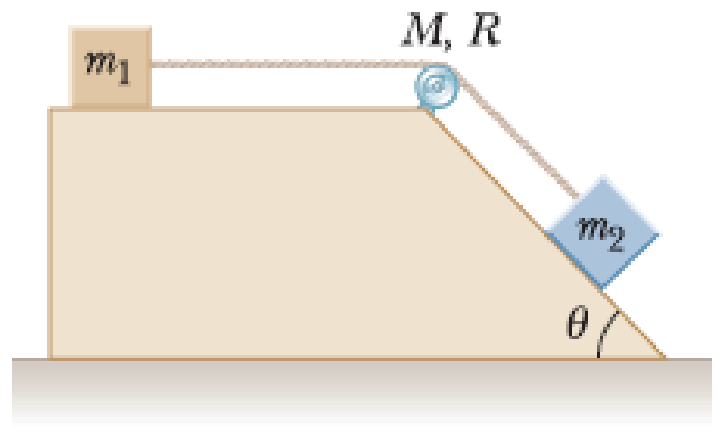
Figure P10.72
(a)
Sketch the force diagrams of both blocks and pulley.
Answer to Problem 72P
The free body diagram of the block of mass
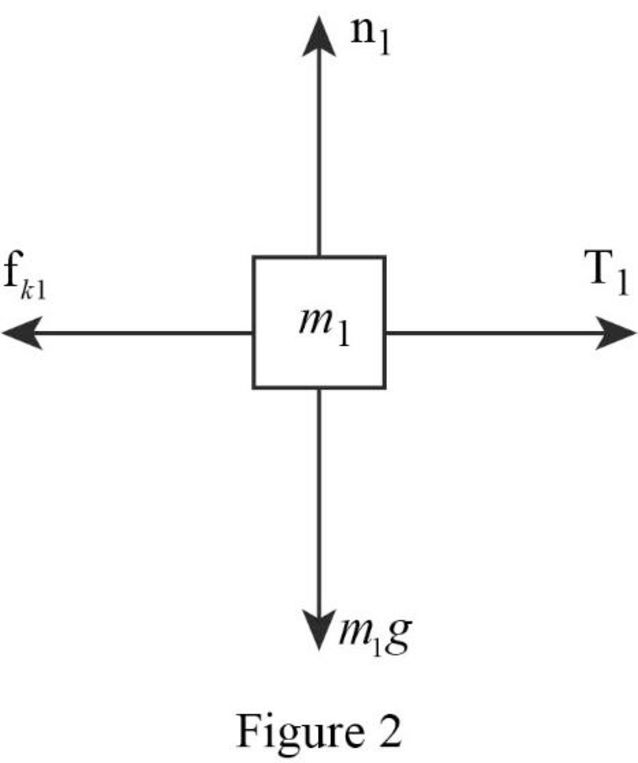
The free body diagram of the block of mass
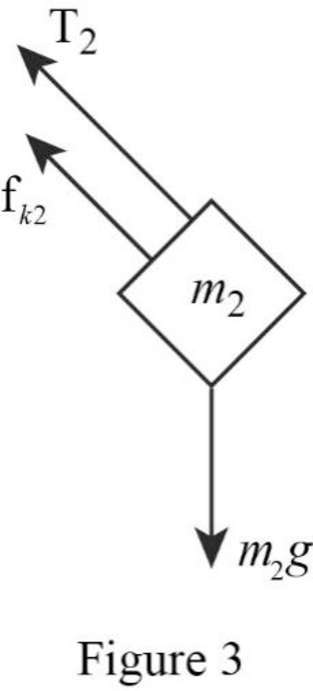
The free body diagram of the pulley is shown below.
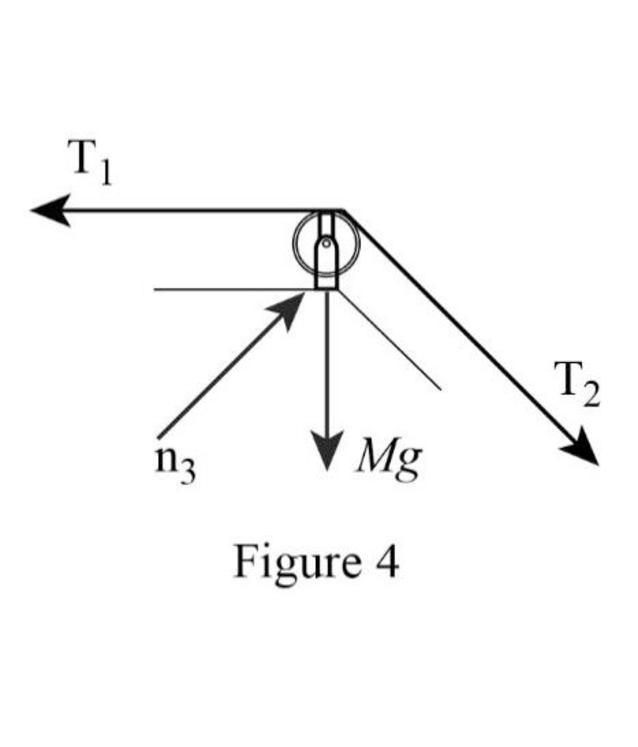
Explanation of Solution
Consider the figure of given system
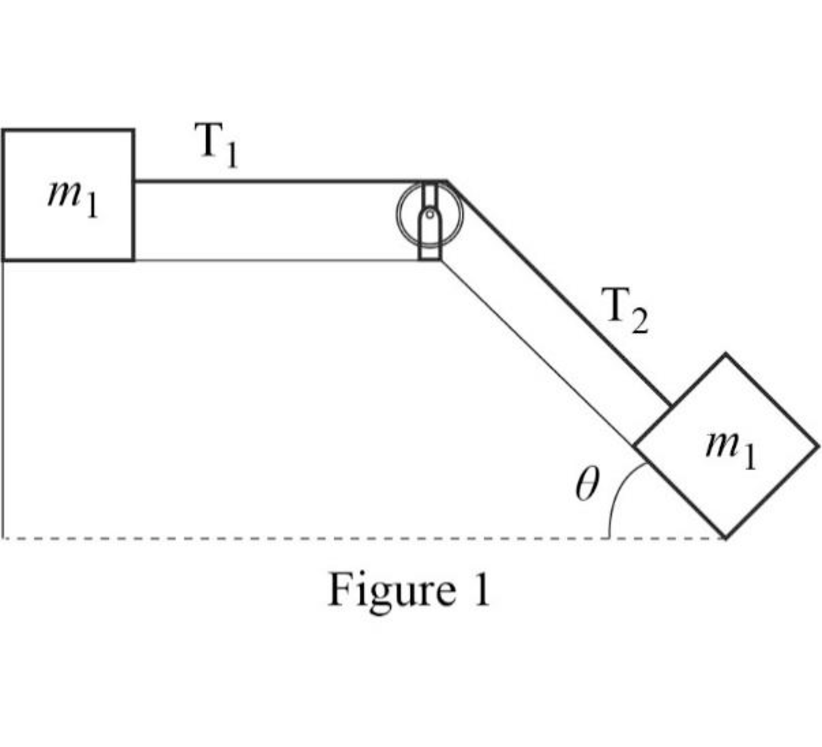
In physics and engineering free body diagrams are used for visualizing the forces, movements, and reaction forces acting on a body. The direction of the forces are also shown in free body diagram using straight arrows.
The free body diagram of the block of mass
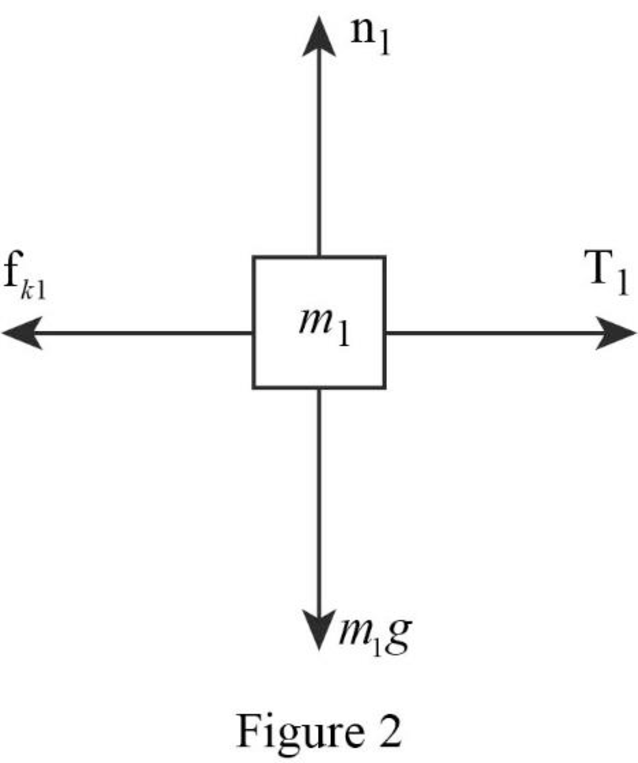
The mass
The free body diagram of the block of mass
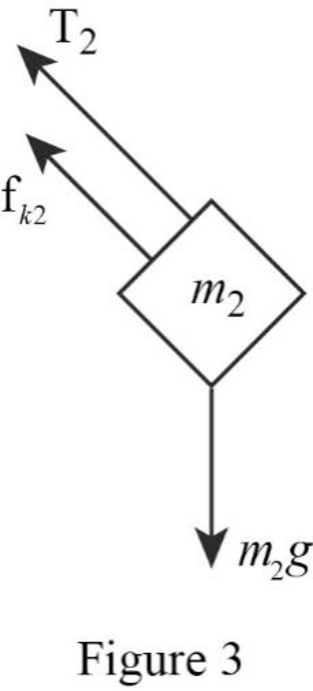
The mass
The free body diagram of the pulley is shown below.
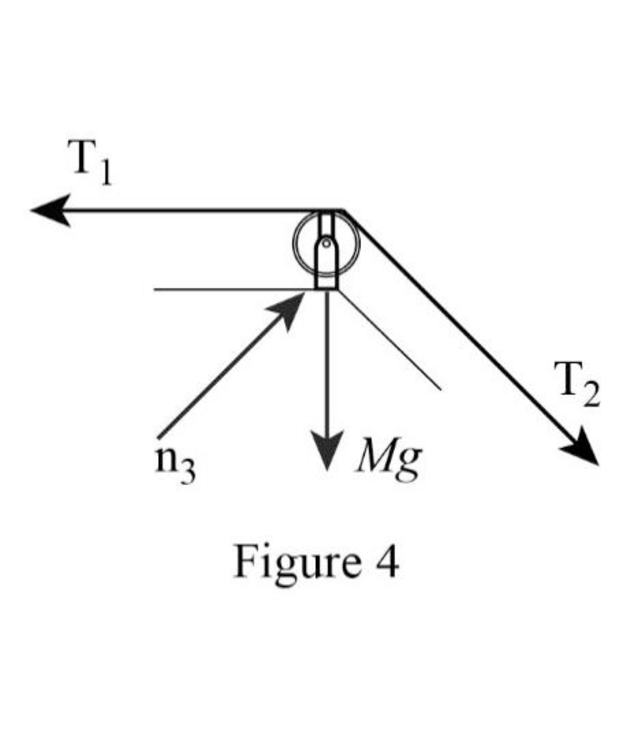
(b)
The acceleration of two blocks.
Answer to Problem 72P
The acceleration of two blocks is
Explanation of Solution
Consider the free body diagram of mass
Write the expression for the total force acting on mass
Here,
The net force acting in vertical direction will be zero, since the normal force and
Rewrite equation (I).
Write the expression for kinetic friction force on
Here,
Write the expression for the force acting in
Here,
Rewrite equation (IV) including the components of forces in horizontal direction.
Write the expression for the total torque.
Here,
Substitute,
Similarly the net force acting on
Write the expression for the kinetic force of friction acting on mass
Write the expression for the forces acting on
Add equation (V), (VII), and (X)
Substitute, equation (IX) and (III) in (XI),
Conclusion:
Substitute,
Therefore, the acceleration of two blocks is
(c)
The tension in the string on both sides of the pulley.
Answer to Problem 72P
The tension in the string on both sides of the pulley is
Explanation of Solution
Use equation (V) and (VII) to obtain the answer.
Conclusion:
Substitute,
Substitute,
Therefore, the tension in the string on both sides of the pulley is
Want to see more full solutions like this?
Chapter 10 Solutions
Principles of Physics: A Calculus-Based Text, Hybrid (with Enhanced WebAssign Printed Access Card)
- No chatgpt pls will upvotearrow_forward1.62 On a training flight, a Figure P1.62 student pilot flies from Lincoln, Nebraska, to Clarinda, Iowa, next to St. Joseph, Missouri, and then to Manhattan, Kansas (Fig. P1.62). The directions are shown relative to north: 0° is north, 90° is east, 180° is south, and 270° is west. Use the method of components to find (a) the distance she has to fly from Manhattan to get back to Lincoln, and (b) the direction (relative to north) she must fly to get there. Illustrate your solutions with a vector diagram. IOWA 147 km Lincoln 85° Clarinda 106 km 167° St. Joseph NEBRASKA Manhattan 166 km 235° S KANSAS MISSOURIarrow_forwardPlz no chatgpt pls will upvotearrow_forward
- 3.19 • Win the Prize. In a carnival booth, you can win a stuffed gi- raffe if you toss a quarter into a small dish. The dish is on a shelf above the point where the quarter leaves your hand and is a horizontal dis- tance of 2.1 m from this point (Fig. E3.19). If you toss the coin with a velocity of 6.4 m/s at an angle of 60° above the horizontal, the coin will land in the dish. Ignore air resistance. (a) What is the height of the shelf above the point where the quarter leaves your hand? (b) What is the vertical component of the velocity of the quarter just before it lands in the dish? Figure E3.19 6.4 m/s 2.1arrow_forwardCan someone help me answer this thank you.arrow_forward1.21 A postal employee drives a delivery truck along the route shown in Fig. E1.21. Determine the magnitude and direction of the resultant displacement by drawing a scale diagram. (See also Exercise 1.28 for a different approach.) Figure E1.21 START 2.6 km 4.0 km 3.1 km STOParrow_forward
- help because i am so lost and it should look something like the picturearrow_forward3.31 A Ferris wheel with radius Figure E3.31 14.0 m is turning about a horizontal axis through its center (Fig. E3.31). The linear speed of a passenger on the rim is constant and equal to 6.00 m/s. What are the magnitude and direction of the passenger's acceleration as she passes through (a) the lowest point in her circular motion and (b) the high- est point in her circular motion? (c) How much time does it take the Ferris wheel to make one revolution?arrow_forward1.56 ⚫. Three horizontal ropes pull on a large stone stuck in the ground, producing the vector forces A, B, and C shown in Fig. P1.56. Find the magnitude and direction of a fourth force on the stone that will make the vector sum of the four forces zero. Figure P1.56 B(80.0 N) 30.0 A (100.0 N) 53.0° C (40.0 N) 30.0°arrow_forward
 Physics for Scientists and Engineers with Modern ...PhysicsISBN:9781337553292Author:Raymond A. Serway, John W. JewettPublisher:Cengage Learning
Physics for Scientists and Engineers with Modern ...PhysicsISBN:9781337553292Author:Raymond A. Serway, John W. JewettPublisher:Cengage Learning Physics for Scientists and EngineersPhysicsISBN:9781337553278Author:Raymond A. Serway, John W. JewettPublisher:Cengage Learning
Physics for Scientists and EngineersPhysicsISBN:9781337553278Author:Raymond A. Serway, John W. JewettPublisher:Cengage Learning Physics for Scientists and Engineers: Foundations...PhysicsISBN:9781133939146Author:Katz, Debora M.Publisher:Cengage Learning
Physics for Scientists and Engineers: Foundations...PhysicsISBN:9781133939146Author:Katz, Debora M.Publisher:Cengage Learning Principles of Physics: A Calculus-Based TextPhysicsISBN:9781133104261Author:Raymond A. Serway, John W. JewettPublisher:Cengage Learning
Principles of Physics: A Calculus-Based TextPhysicsISBN:9781133104261Author:Raymond A. Serway, John W. JewettPublisher:Cengage Learning College PhysicsPhysicsISBN:9781285737027Author:Raymond A. Serway, Chris VuillePublisher:Cengage Learning
College PhysicsPhysicsISBN:9781285737027Author:Raymond A. Serway, Chris VuillePublisher:Cengage Learning Glencoe Physics: Principles and Problems, Student...PhysicsISBN:9780078807213Author:Paul W. ZitzewitzPublisher:Glencoe/McGraw-Hill
Glencoe Physics: Principles and Problems, Student...PhysicsISBN:9780078807213Author:Paul W. ZitzewitzPublisher:Glencoe/McGraw-Hill





